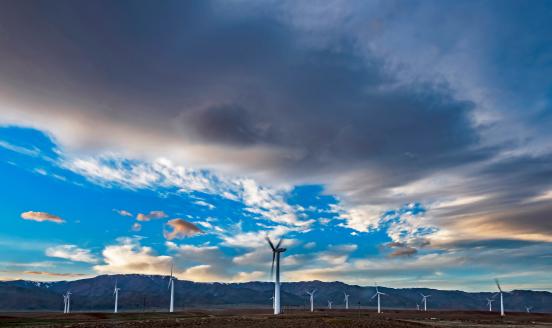The Economists’ Statement on Carbon Dividends and the Green New Deal
In the last month two prominent policy proposals that aim to combat climate change have been presented in the United States. The Green New Deal calls

On 6 February, Democratic members of the US Congress put forward a House Resolution that recognises “the duty of the Federal Government to create a Green New Deal”. This Green New Deal would be a “new national, social, industrial, and economic mobilization on a scale not seen since World War II and the New Deal era” with the aims of “achieving net-zero greenhouse gas emissions”, “creating millions of good, high-wage jobs”, “ensuring prosperity and economic security for all people of the United States” and investing in sustainable industry and infrastructure. The proposal combines concrete policy proposals for carbon mitigation (“investment in zero-emission vehicle infrastructure and manufacturing”), with broader social goals (“guaranteeing a job with a family-sustaining wage, adequate family and medical leave, paid vacations, and retirement security to all people of the United States”).
A different approach to mitigate climate change was proposed on 17 January by 45 prominent economists. More than 3000 economists have since signed the proposal. The Economists’ Statement on Carbon Dividends calls for a tax on carbon emissions that increases every year. The revenues would be returned to US citizens through equal lump-sum rebates and the establishment of a border carbon adjustment system prevents carbon leakage and protects US competitiveness. The tax would send a price signal that replaces the need for less efficient carbon regulations, promote economic growth and provide regulatory certainty needed for long-term investment in clean-energy alternatives.
Noah Kaufman finds it remarkable that a group of such ideologically, politically and academically diverse economists publicly support this specific policy change, as it is notoriously difficult to find consensus among economists. What might have helped the emergence of consensus in this case? Kaufman reviews the recommendations and classifies them into economic principles and policy judgements. He asserts that the majority of recommendations reflect basic principles of economics applied to climate policy. These are the recommendation in favour of a carbon tax as a cost-effective way to reduce emissions, the assessment that the tax makes some regulations redundant and the requirement for a border carbon adjustment mechanism to enable the ideal functioning of the envisioned carbon tax. Furthermore, the call for annual increases in the carbon tax is supported by the economic literature as a measure that can drive long-term investment while avoiding near-term economic disruption. But the recommendation to return all carbon tax revenues directly to US citizens is a policy judgment, according to Kaufman. He thinks that many economists would support the use of revenues to reduce other distortionary taxes instead of a lump-sum rebate, because the former would improve the overall economic outcome.
Several other commentators have objected to the idea of equally redistributing the carbon tax revenues. Michael R. Strain writes on Bloomberg Opinion that there are in fact two proposals in the Economists’ Statement – one for a carbon tax and one for a universal basic income. Though the rebates in the first year would be small (around $2,000 per year for a family), the creation of the mechanism would allow for substantial increases by future politicians. Strain fears that a full blown universal basic income would, among other things, reduce the number of people who are willing to work. He thinks that using the carbon tax to reduce income taxes or fund innovation in green technologies would be a better policy than the dividend payment.
Tyler Cowen signed the Statement but takes issue with the lump-sum rebate recommendation. He argues that it shifts the emphasis of the policy towards redistribution and creates an illusion of the carbon tax being a “free lunch”. Like others, he proposes to use the revenue to fund solutions to the problems of climate change or to reduce government debt.
John H. Cochrane is another signatory of the statement. On his blog he says he is in favour of the tax because it is the only way to change people's behaviour. Defending the proposal against global warming sceptics, he argues that given overwhelming demands on the government to act on climate change, a tax is less damaging than regulations or subsidies. Arguing with “carbon warriors”, he insists that in the context of the political system, a carbon tax is going to reduce carbon emissions much more than subsidies and regulations. Cochrane weighs the arguments for and against the lump-sum rebate proposal and concludes that, although compensating for other distortionary taxes would be preferable, the proposed solution at least guarantees that the tax revenue is not being spent on “ever larger green boondoggles like the California high-speed train to nowhere”.
In a follow-up blog post, Cochrane notes that determining the size of the carbon tax is neither obvious nor trivial. While a document associated with the Economists’ Statement proposes an initial tax of around $40 per ton of CO2, the final levy will look very different depending on the ultimate target. One option could be to set the tax to the “social cost of carbon”, which is the estimated cost that a polluter imposes on others. This would imply a rather small tax. Another option would be to target a temperature or quantitative level. Such a tax should be high enough to at one point completely deter the use of fossil fuels. This implies a very high final carbon tax and very low carbon dividends, because such high carbon taxes would quickly erode the tax base.
Noah Kaufman notes that the Economists’ Statement recommends carbon tax increases “until emissions reductions goals are met”. This indeed implies that the tax rate will not be set at the social cost of carbon but to achieve a quantitative target. (Maximilian Auffhammer explains in the Journal of Economic Perspectives how economists estimate the social cost of carbon.)
Beatrice Cherrier reminds us of the ‘Economists’ Statement on Climate Change’ which was signed in 1997 by 2500 economists, including eight Nobel Laureates. In a tweetstorm she compares the two statements. While the 1997 version proposed two market-based policies, carbon taxes and the auction of emissions permits, the 2019 statement does not mention emission permits and promotes the carbon tax as “the most cost-effective lever to reduce carbon emissions”. Furthermore, the earlier version suggested using the tax revenue to reduce the deficit or cut other taxes, while the new statement calls for lump-sum rebates of tax revenue. But the context in which these statements have been made has also changed. While the 1997 piece was probably intended to inform the public about economic policies to combat climate change, the 2019 statement emerged in the context of a contest between different climate change mitigation policies.
The Financial Times quotes Ted Halstead, one of the co-authors of the 2019 Economists’ Statement, asserting: “America has two choices, one is the route of the Green New Deal, one is the route recommended by the entire economic establishment, which is the carbon dividend plan”. So are economists opposing the Green New Deal?
Noah Smith writes on Bloomberg Opinion that the Green New Deal, as it has been presented in Congress (see link above), is not affordable. While he thinks that the environmental policies that the Deal envisions are highly ambitious but necessary, Smith criticises the large list of social goals that makes the Green New Deal a vast programme for economic egalitarianism, which would result in an enormous expansion of the welfare state and poses the threat of excessive budget deficits.
However, this does not mean that Smith, as Halstead puts it, chooses the route of the carbon dividend plan. On Twitter he writes that the carbon dividend plan under-emphasises technology and international incentives and that he sees more potential in the environmental policy propositions of the Green New Deal. While the carbon tax is a useful tool, he criticises it for not doing enough to reduce carbon emissions outside of the United States, which is where he thinks “the climate change battle will be won or lost”. In a second Bloomberg Opinion article, he highlights the importance of subsidies to green-energy companies and government funded R&D of green technologies. More than 85 percent of global carbon output is emitted outside of the United States and Smith argues that these emissions can be reduced by developing and quickly proliferating carbon-free technologies. Policies as proposed by the Green New Deal seem much more suited to this end than the carbon dividend proposal.
Ramez Naam agrees with Smith on the importance of the global picture. He argues that the US’s most powerful lever to reduce global carbon emissions is the subsidisation of green technologies. Naam states that, because of the learning curve effect, which is the reduction of production costs arising from repeated production, German subsidies for solar power made solar panels cheaper for the whole world. With its size and financial power, the United States could reduce global costs of renewable energy substantially, having an impact on carbon emissions that goes well beyond its territory. Furthermore, Naam points to what he calls the biggest climate problems: agriculture and industry. While technologies are being developed to decarbonise the power sector, these two sectors will soon be the largest emission sources in the US – and they lack solutions. To make progress on these issues, he proposes government funds that promote research into methane-free livestock holdings and decarbonised heavy industry.
Leah Stokes evaluates the Green New Deal on Twitter and thinks that it is well focused on the work that is necessary to keep planet earth inhabitable. While it is non-binding, she sees the Green New Deal as a symbolic but important effort that sends the message to private individuals and companies that the climate crisis is real and that a lot of time and resources will go into fixing it. Stokes hopes that this will affect the expectations of economic actors, signalling to companies that finding ways to reduce carbon emissions is going to offer lucrative business opportunities.
Simon Wren-Lewis argues that climate change mitigation measures should not be judged on whether they can be afforded but on how effective they will be at achieving their goal. Because politicians seem reluctant currently to fully tackle a potentially existential climate change crisis, he agrees with proponents of the Green New Deal that large-scale government-led programmes are required. He acknowledges that it might be impossible to make current polluters pay, because of incomplete information or the unequal distribution of political power. However, this does not need to be the end of a Green New Deal. Based on an argument originally made by John Broome, Wren-Lewis asserts that funding climate change mitigation through government debt is still a Pareto improvement. If one assumes that climate change will have irreversible and catastrophic effects, it is still be better to pass on the bill for stopping climate change to future generations, than making them inherit a destroyed planet.
Martin Wolf thinks that the two different plans to attack climate change could be combined in a workable compromise. Wolf acknowledges that the price mechanism is powerful, but doubts that it is powerful enough to tackle the challenges of irreversible changes in climate. What is also needed, he argues, is the Green New Deal’s sense of urgency and its focus on regulation and investment. Furthermore, to make the fight against climate change global, Wolf argues for a combination of export subsidies for low-carbon technology and border carbon taxes. As a consensus about the existence of the threat of climate change is emerging for the first time, he calls for a hard push to agree on a workable plan.



